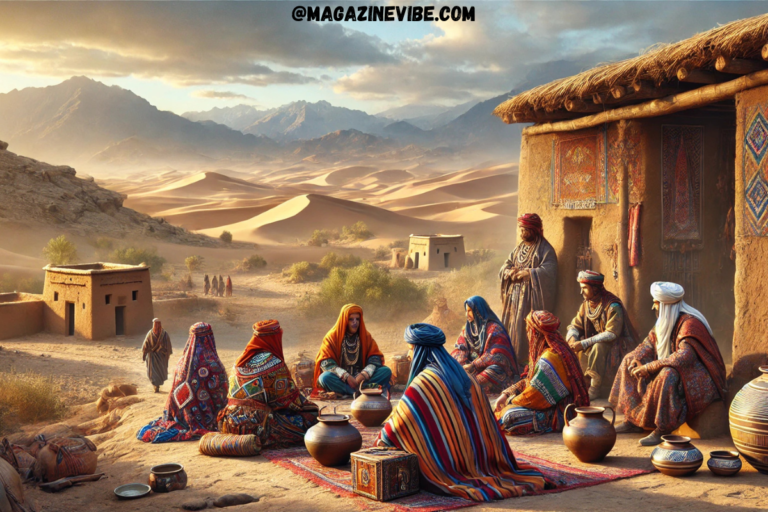Introduction to the Amaziğ People and Culture
The Amaziğ, also called Berbers, are one of the oldest indigenous groups in North Africa. Their history goes back thousands of years. The name “Amaziğ” means “free people” or “noble people,” which reflects their proud and independent spirit.
The Amaziğ people live mainly in Morocco, Algeria, Tunisia, Libya, Mali, Niger, and other parts of North Africa. Some also live in Europe and other places due to migration. Despite living in many countries, the Amaziğ share a strong cultural identity that connects them across borders.
The word “Amaziğ” is not just a name. It represents a deep cultural heritage and the identity of the people. For the Amaziğ, their language, traditions, and history are crucial parts of who they are. They take pride in their customs, passing them down from generation to generation.
In North African history, the Amaziğ people have played a significant role. They were involved in ancient trade routes and have contributed to the region’s rich cultural landscape. Today, they continue to preserve their culture while facing challenges in modern society.
The Origins of the Amaziğ Language
The Amaziğ language, known as Tamazight, is a central part of Amaziğ identity. It is spoken by millions of people across North Africa. Tamazight belongs to the Afro-Asiatic language family, which means it has existed for thousands of years.
Throughout history, Tamazight has developed and changed as different groups of people spread across various regions. It includes many dialects, such as Tachelhit, Kabyle, and Tuareg, each spoken in different areas. Despite these variations, all Amaziğ dialects share common roots.
Language is vital in preserving Amaziğ culture. For many years, it was passed down through generations orally. Today, efforts are being made to keep the language alive, especially in education and media. In some countries like Morocco and Algeria, Tamazight is recognized as an official language, helping to protect it for future generations.
Amaziğ Traditions and Customs
Amaziğ people have rich traditions and customs that reflect their unique culture. One of the most well-known aspects of Amaziğ life is their traditional practices, which include everything from agriculture to craft-making. Their methods are often based on ancient knowledge passed down from their ancestors.
Amaziğ clothing, music, and dance are key cultural expressions. The traditional clothing is often brightly colored and embroidered, especially during festivals and important events. Music and dance are used to tell stories and celebrate special occasions. Instruments like the bendir (drum) and imzad (a one-stringed fiddle) are commonly used in their performances.
Festivals are another important part of Amaziğ culture. Many of these are linked to agriculture or religion. For example, the Yennayer festival marks the Amaziğ New Year. It is a time for families to gather, share meals, and celebrate their heritage.
Storytelling is an ancient tradition among the Amaziğ. Oral history, told through stories, poems, and songs, plays a key role in keeping the culture alive. These stories often carry important life lessons and connect the younger generation with their heritage.
Amaziğ Art and Architecture
Amaziğ people have made significant contributions to art and architecture that are still admired today. Traditional Amaziğ art includes pottery, jewelry, weaving, and carpet-making. These items are often handmade and decorated with intricate geometric patterns and symbols. Each piece of art reflects the culture, environment, and beliefs of the Amaziğ people.
Amaziğ architecture is also unique. In rural areas, houses are often built from natural materials like stone, mud, and wood, designed to blend into the landscape. The ksour (fortified villages) and kasbahs (fortified homes) are famous examples of Amaziğ architecture, showcasing practical yet beautiful designs. These structures often feature decorative carvings and symbols that carry deeper meanings, such as protection or prosperity.
Art and architecture have deep symbolic meanings in Amaziğ culture. The patterns used in their crafts often represent important aspects of life, such as fertility, nature, and spirituality. For instance, triangular shapes may symbolize the female form, while zigzag patterns often represent water or protection.
Amaziğ art has had a lasting impact on North African aesthetics. The influence of their designs can be seen in modern Moroccan and Algerian art, as well as in architecture and fashion. Amaziğ symbols and patterns are used today in everything from jewelry to modern home decor.
Challenges Facing the Amaziğ People
Despite their rich culture, the Amaziğ people face cultural marginalization in some parts of North Africa. For many years, their language and customs were not officially recognized by the governments of countries where they live, such as Morocco and Algeria. However, in recent years, there have been efforts to preserve the Amaziğ identity and give it the respect it deserves.
One major challenge has been the political struggles for Amaziğ recognition. Historically, many North African governments favored Arabic culture and language, which led to the suppression of Amaziğ traditions. Today, Amaziğ activists continue to fight for equal rights, cultural recognition, and political representation.
Efforts to revive and maintain the Amaziğ language have been a key part of this struggle. In Morocco and Algeria, the language is now recognized as official, but there is still a lot of work to be done to ensure that it is taught in schools and used in public life.
On the international stage, there is growing support for the rights of Amaziğ communities. Human rights organizations, along with Amaziğ advocacy groups, are working to raise awareness about the issues faced by Amaziğ people and ensure that their cultural and linguistic rights are protected.
The Role of the Amaziğ in Modern Society
In modern times, Amaziğ people continue to contribute to the development of North African societies. Many Amaziğ individuals have achieved notable success in politics, arts, and activism. For instance, Ahmed Ouyahia, the former Prime Minister of Algeria, and Fatima Mernissi, a Moroccan feminist and sociologist, are both of Amaziğ descent. Their contributions have shaped both local and global conversations.
The global Amaziğ diaspora also plays an important role in spreading awareness about their culture. Amaziğ communities in Europe, particularly in France and Spain, have formed strong cultural organizations. These groups help preserve their traditions, teach the younger generation about their roots, and advocate for the rights of Amaziğ people worldwide.
In North Africa, the Amaziğ people have become more visible in public life. They contribute to the economies and cultures of countries like Morocco, Algeria, and Libya while maintaining their distinct identity. From politicians to artists, the Amaziğ are making their mark on modern society while proudly preserving their heritage.
Amaziğ and the Digital Age
In the digital age, the Amaziğ people have found new ways to preserve and promote their culture using social media and online platforms. These platforms have become crucial tools for Amaziğ communities to share their traditions, language, and heritage with a wider audience. Through Facebook, Instagram, and YouTube, Amaziğ individuals and groups share cultural content, including music, language lessons, and historical stories, helping younger generations stay connected to their roots.
There are also many online resources available to help people learn the Amaziğ language, Tamazight. Websites and apps like Memrise and YouTube channels offer Tamazight language lessons, making it easier for people worldwide to access and learn this ancient language. These tools play a significant role in keeping the language alive, especially among the Amaziğ diaspora who may not have access to formal education in their native language.
The internet has also become a space for global movements that raise awareness about Amaziğ rights and issues. Advocacy groups use digital platforms to campaign for the preservation of the Amaziğ culture, recognition of their language, and equal political rights in North African countries. Social media campaigns and online petitions have helped bring international attention to the struggles of the Amaziğ people, increasing support for their cause from human rights organizations and cultural institutions around the world.
Amaziğ Cuisine: A Taste of North African Heritage
Amaziğ cuisine is a reflection of their close connection to nature and their land. Their traditional foods are simple but rich in flavor, often made from ingredients that have been grown or sourced locally for centuries. These foods represent not only the daily life of the Amaziğ people but also their deep cultural and historical roots in North Africa.
Some of the most popular Amaziğ dishes include couscous, tagine, and rfissa. Couscous is made from semolina wheat and is often served with vegetables, meat, or fish. Tagine, named after the clay pot in which it is cooked, is a slow-cooked stew made with various meats, spices, and vegetables. Rfissa is a comforting dish made with chicken, lentils, and a rich broth seasoned with fenugreek. Many of these dishes are cooked with olive oil, spices like cumin and saffron, and fresh herbs, reflecting the natural bounty of North Africa.
Amaziğ cuisine has significant cultural importance. It is often shared during festivals, weddings, and other important community gatherings. Meals are a time for families to come together, and the food often has symbolic meanings. For example, couscous is traditionally eaten at celebrations and religious holidays, symbolizing abundance and generosity.
The influence of Amaziğ cooking on North African cuisine is undeniable. Many dishes that are now considered typical of Moroccan and Algerian cuisine, like couscous and tagine, have their roots in Amaziğ culture. Over the centuries, the flavors and techniques of Amaziğ cooking have spread throughout the region, blending with other culinary traditions to create the rich and diverse food culture of North Africa today.
The Future of the Amaziğ People
The Amaziğ people are actively working to protect and promote their identity in the modern world. There are several initiatives aimed at preserving their language, culture, and traditions. In countries like Morocco and Algeria, efforts have been made to include Tamazight in schools, making sure the younger generation grows up speaking the language. Festivals celebrating Amaziğ culture, such as the Tafraout Almond Festival and Timitar Festival, showcase Amaziğ music, dance, and art, helping keep these traditions alive.
The younger generation plays a crucial role in preserving the Amaziğ heritage. Through social media, music, and activism, many young Amaziğ are embracing their roots and sharing their culture with the world. They are using technology to make their voice heard, ensuring that the Amaziğ identity remains strong in the 21st century.
However, there are still challenges facing the Amaziğ people. Cultural marginalization, political struggles, and the pressures of modernization continue to threaten their way of life. But there are also opportunities. With growing international support and a renewed focus on indigenous rights, the Amaziğ people are finding new ways to protect their heritage and culture.
The future of the Amaziğ depends on their ability to balance tradition with modernity. By continuing to celebrate their identity and adapt to the changing world, the Amaziğ people can ensure that their culture thrives for generations to come.
Conclusion
The Amaziğ people have a rich cultural heritage that spans thousands of years, deeply rooted in their language, traditions, art, and cuisine. Despite facing many challenges over the centuries, they have remained resilient, preserving their unique identity in the face of cultural and political pressures. Their contributions to North African history, from their art and architecture to their influence on cuisine, continue to shape the region today.
As we look to the future, the Amaziğ people are finding new ways to protect and celebrate their heritage, especially through modern technology and global movements. With the support of younger generations and the international community, the Amaziğ culture stands strong, continuing to inspire and thrive in the 21st century. The legacy of the Amaziğ is not just a part of North Africa’s past, but a living and evolving culture that will carry forward for generations.


